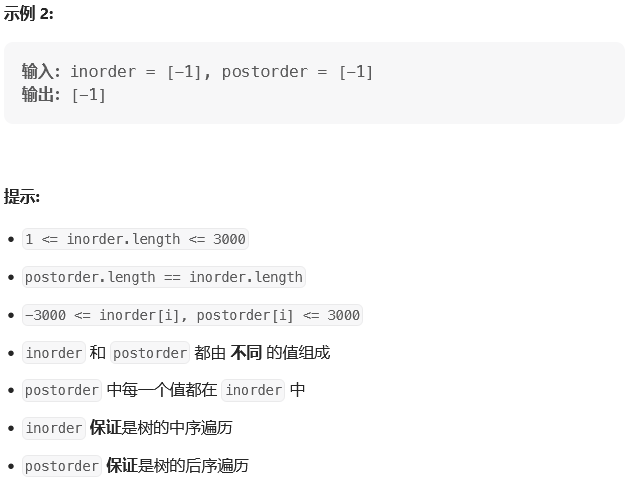106. 从中序与后序遍历序列构造二叉树
题目:


思路:
【1】可以借鉴 剑指 Offer 07. 重建二叉树(105. 从前序与中序遍历序列构造二叉树) 这一篇,因为本质思路都是一样的。
【2】常规模拟分割的方式
代码展示:
【1】常规模拟分割的方式(这种方式通俗易懂,是将大树构建的方式划分为了小树的构建然后组合成大树,由于划分的时候需要每次都获取中序遍历的位置,所以一开始采用了一次遍历并将数据存于hashMap中便于查找来避免了每次需要遍历获取下标这一步)
//时间2 ms 击败 48.96% //内存42.4 MB 击败 23.24% /** * Definition for a binary tree node. * public class TreeNode { * int val; * TreeNode left; * TreeNode right; * TreeNode() {} * TreeNode(int val) { this.val = val; } * TreeNode(int val, TreeNode left, TreeNode right) { * this.val = val; * this.left = left; * this.right = right; * } * } */ class Solution { private Map<Integer, Integer> indexMap; /** * 将两个序列复原出一个树 * @param inorder 中序遍历(左中右) * @param postorder 后序遍历(左右中) * @return */ public TreeNode buildTree(int[] inorder, int[] postorder) { int n = inorder.length; // 构造哈希映射,帮助我们快速定位根节点 indexMap = new HashMap<Integer, Integer>(); for (int i = 0; i < n; i++) { indexMap.put(inorder[i], i); } return myBuildTree(postorder, inorder, 0, n - 1, 0, n - 1); } public TreeNode myBuildTree(int[] postorder, int[] inorder, int postorder_left, int postorder_right, int inorder_left, int inorder_right) { if (postorder_left > postorder_right) return null; // 后序遍历中的最后一个节点就是根节点 int preorder_root = postorder_right; // 在中序遍历中定位根节点 int inorder_root = indexMap.get(postorder[preorder_root]); // 先把根节点建立出来 TreeNode root = new TreeNode(postorder[preorder_root]); // 得到左子树中的节点数目 int size_left_subtree = inorder_root - inorder_left; // 得到右子树中的节点数目 int size_right_subtree = inorder_right - inorder_root; // 递归地构造左子树,并连接到根节点 // 后序遍历中「从 左边界 开始的 size_left_subtree - 1」个元素(因为 左边界 + size_left_subtree = 刚好到目标位置多走了一步) // 就对应了中序遍历中「从 左边界 开始到 根节点定位-1」的元素 root.left = myBuildTree(postorder, inorder, postorder_left , postorder_left + size_left_subtree - 1 , inorder_left, inorder_root - 1); // 递归地构造右子树,并连接到根节点 // 后序遍历中「从 左边界+左子树节点数目 开始到 右边界 - 1」的元素(因为最后的那个元素已经拿出来作为根节点了) // 就对应了中序遍历中「从 根节点定位+1 到 右边界」的元素 root.right = myBuildTree(postorder, inorder, postorder_left + size_left_subtree, postorder_right - 1, inorder_root + 1, inorder_right); return root; } }
【2】进行比对的部分(原本想着Map直接获取吧应该会比较快,然而实际上,缩短遍历范围的遍历,远比在map中查找获取更快,难道是因为是map内部获取的操作其实远远复杂于遍历查找的过程?)
//时间0 ms 击败 100% //内存42.3 MB 击败 33.4% class Solution { int i; public TreeNode buildTree(int[] inorder, int[] postorder) { i = postorder.length-1; return build(inorder,postorder,0,inorder.length-1); } TreeNode build(int[] inorder,int[] postorder,int inBegin,int inEnd){ if(inBegin>inEnd){ return null; } TreeNode root = new TreeNode(postorder[i]); int rootIndex = find(inorder,inBegin,inEnd,root.val); i--; root.right = build(inorder,postorder,rootIndex+1,inEnd); root.left = build(inorder,postorder,inBegin,rootIndex-1); return root; } int find(int[] inorder,int inBegin,int inEnd,int val){ for(int j=inEnd;j>=inBegin;j--){ if(inorder[j]==val){ return j; } } return -1; } } //时间2 ms 击败 48.96% //内存42.2 MB 击败 42.57% class Solution { private Map<Integer, Integer> indexMap; int i; public TreeNode buildTree(int[] inorder, int[] postorder) { i = postorder.length-1; // 构造哈希映射,帮助我们快速定位根节点 indexMap = new HashMap<Integer, Integer>(); for (int i = 0; i < inorder.length; i++) { indexMap.put(inorder[i], i); } return build(inorder,postorder,0,inorder.length-1); } private TreeNode build(int[] inorder,int[] postorder,int inBegin,int inEnd){ if(inBegin>inEnd){ return null; } TreeNode root = new TreeNode(postorder[i]); int rootIndex = indexMap.get(postorder[i]); i--; root.right = build(inorder,postorder,rootIndex+1,inEnd); root.left = build(inorder,postorder,inBegin,rootIndex-1); return root; } }

